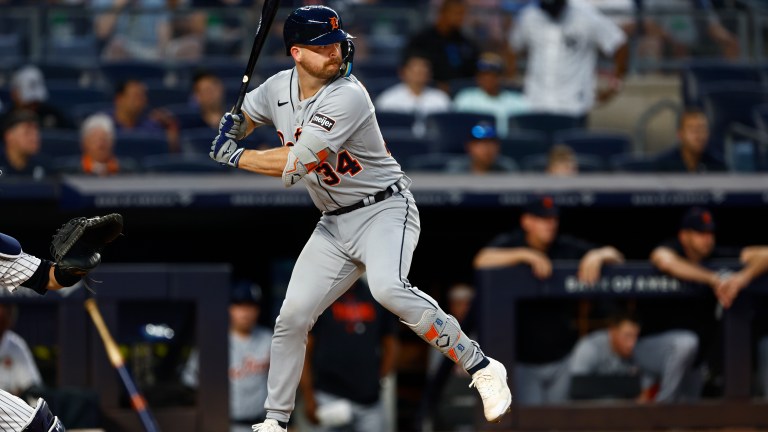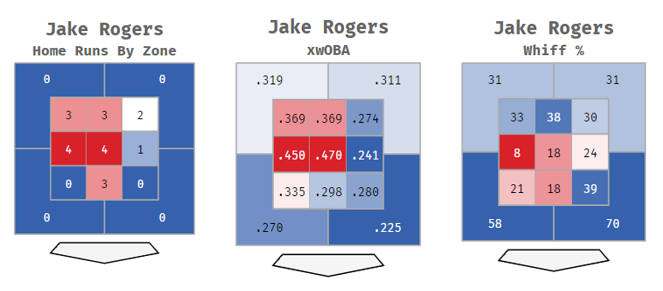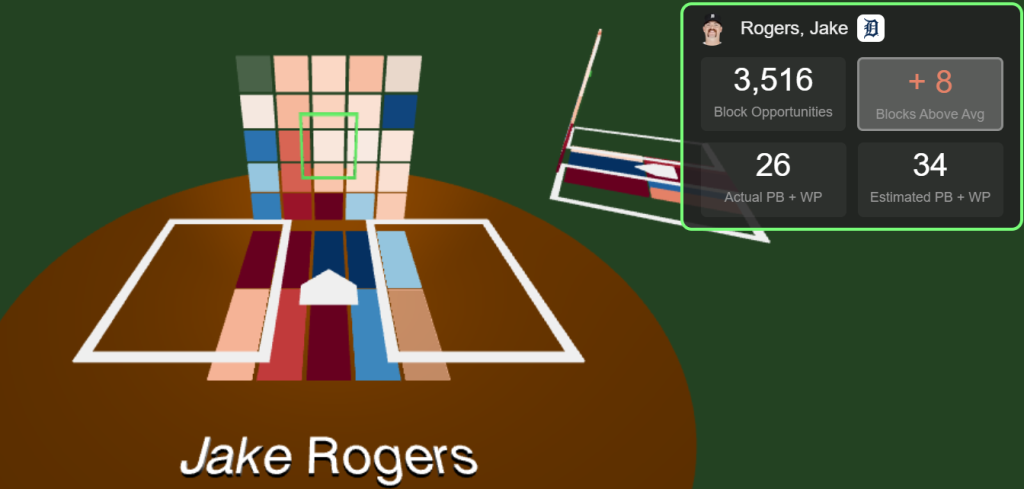What to Expect From Detroit Tigers’ Catcher Jake Rogers in 2024
While he might not yet be considered a top catcher in MLB, Jake Rogers is an underrated player who has earned an everyday role in Detroit.

January is the month of list. Top ten this, top 100 that. A name you won’t find on any top catchers list is Jake Rogers, but he’s not as far off as you think. The last player remaining from the Justin Verlander to Houston trade is coming off his first “full” season in the show.
Rogers finished just 0.2 fWAR away from cracking the top 10 in fWAR for catchers despite playing in only 107 games. A plus defender with 20 home run pop from behind the plate should make more people take notice. However, swing and miss issues are anchoring him from truly taking off. So, what can we expect from the 28 year-old back stop heading into 2024 and just how high is his ceiling?
Offense
2023 Stats: .221/.286/.444, 21 HR, 49 RBU, 7.7% BB, 32.3% K, 97 wRC+
The average baseball fan probably had no idea that Jake Rogers hit 21 home runs last season. As far as catchers, 21 ties him for sixth most with Sean Murphy. Of the catcher in the 10 ten in home runs, Rogers had the least at bats. If you missed them, I’ve got you covered:
As you can see, there’s some serious power. Rogers has no problem barreling up baseball’s and turning them into souvenirs. His power has potential to make him a top notch offensive catcher, but the swing an miss is holding him back. Rogers struck out 32.7% of the time last year with a 33% whiff rate. He especially struggled against non-fastballs whiffing at 36% of breaking balls and 37% of off speed pitches. Believe it or not, those numbers are an improvement from a small sample we saw in 2021.
The good news? Roger’s doesn’t chase pitches out of the zone. His 23.5% chase rate is roughly 5% lower than the league average, and 20% lower than Javier Baez. So, his strikeouts are a bad, but at least it is not swinging at everything, bad. To me, improving on your in zone swing and miss might be easier than teaching yourself not to chase.
Rogers in zone contact rate (z-contact%) is 78.9%, well below the roughly 87% league average. Even a slight improvement in this area could go along way. Contact, when you have power like this, can shift a game in a hurry.
As his sample size grows, pitchers will learn more about his weaknesses. Velocity is not as much of an issue with Rogers. Driving fastballs is his bread and butter. He did not experience a large jump in the breaking balls or off speed he saw last year. Heading into 2024, that could be much different.
Another focus from pitchers will be where exactly they pitch Rogers. How about on the outside third of the plate where he struggled to make contact and when he did, it was rather weak. Living fastball/breaking ball on the outside third could really force Rogers to spiral. Something to keep an eye on next season.

Via Baseball Savant
Defense
A catchers primary job is handling the pitching staff. Calling a game, framing, and blocking pitches in the dirt are a priority and Rogers holds his own defensively. Not long ago Rogers was regarded as the top defensive catching prospect by industry leaders. In his first full season of work Rogers was tied for 11th in catcher framing runs with five which puts him in the 80th percentile.

Via Baseball Savant
A notable improvement from previous years which is actually common with catchers. Sure, framing will not hold the same value in the future but stealing strikes is a huge advantage for a pitching staff. Another offseason working with this staff and understanding their pitch movement further can lead to another jump in his framing metrics.
Another area where Rogers excels is blocking pitches. On the surface you might not think about catchers blocking pitches too often, but keep in mind poorly blocked balls often times turn into an extra 90 feet for a baserunner. Last season he ranked tied for sixth in blocks above average which slots him in the 90th percentile.

Via Baseball Savant
Where blocking plays a huge role that we cannot measure is confidence in pitchers. No fancy graph or metric, but it is real. Picture a pitchers count with a runner on second. That pitcher will be much more confident in throwing a breaking ball in the dirt trying to get a batter to chase when Rogers is behind the plate.
An area of improvement is in the run game. A blend of delivery, pop time, exchange, arm strength, and accuracy makes measuring this somewhat wonky. Long story short, Rogers threw out about 2% less than what would be expected. I’ll let you use your own judgement as I have pieced together a video of his attempts from this season.
Although each clip is unique in itself, a couple of common themes: arm strength and arm slot. At times Rogers drops his throwing motion, more out of necessity, and the ball does not have the same velocity or accuracy. Even when all goes well, arm strength is still a problem. Rogers ranked tied for 57th in arm strength with an average of 76.7 mph, making accuracy even more important.
Expectation
After a promising first full year I understand why people are excited about Rogers. Another healthy offseason added to a larger role and more at bats could translate into a 30 home run, 4 plus WAR season. No doubt, there is a chance that very well could happen. There’s also a chance the swing and miss catches up to him. Pitchers attack him differently and adjustments need to be made on the fly.
I’m going to lean towards 18-22 home runs, sub .225 average, and around a 90 wRC+. I know Tigers fans will disagree with this prediction, but I think last year’s counting stats and pace are not the standard. Close, not far off, but not the write in ink stats.
Regardless, an expanded role is exactly what Rogers needs. He’s earned the opportunity to show he can be an everyday catcher for this next version of Tigers baseball. Even if the totals don’t trend they way you thought they would, his defense will keep his value. The Tigers should bring Dillon Dingler along slowly, learning how to lead a staff and call a game from Rogers. If all goes well, a position of weakness a year ago starts to look like a strength.

